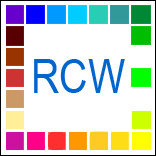Deborah Batterson wrote:
>
> Thank you! Yes, you can use the question..and my full name ...
Thanks,
> but I am still trying to understand your answer. What color would you call #17? (As it is not listed)
RCW#17 is between purple#16 and ultramarine violet#18, there is no tube color for #17. As far as that goes, ultramarine violet#18 should be called ultramarine purple. That would leave room for the ultramarine violet as #17. Violet is #14.
> Also, Which # would you consider as "indigo" on the wheel? THANK-YOU!!!! (:
The term indigo is not used by most artists anymore, except by Prismacolor, more recently it used to be the color of blue jeans, but they dropped it too. Fine Indigo was India's transparent hue, the color of cyan, back when Phoenicia was a world power. Today there are better and faster ways to make true transparent cyan, indigo has become a quickly made, dirty color.
From the earliest High Art period in 2000 BC when Arsenic was Yellow, Transparent indigo and opaque frit were Cyan, and Karmes-Nacarat Carmine was Magenta.
Other colors in the past that were akin to cyan were, Azurite, Blue Vitriol or Pompiian Blue Lake, Ferris-cyan, Indigo, Bremen Blue or a native Cobalt Blue that had a cyan color.
The way to find answers on this DVD is to go to a page that has a search box feature, like..
http://www.realcolorwheel.com/sitetree.htmOr the main page,
http://www.realcolorwheel.com/final.htmType in a word or phrase like indigo.
Basically, indigo has changed so many times it's not a reliable hue. Today we call that primary color cyan.
Don
>>
>> Deborah Batterson wrote:
>> Hello Don,Thank you for the beautiful color wheel and the
>> added 5" wheel. That was very nice of you and I appreciate it!
>>
>>
>> I wonder if you could tell me why "purple " and "violet" are labeled
>> as they are. It seems to me (but Im not the expert) that the "purple" is
>> label should be "violet", and visa versa with all due respect! Deborah
>> Batterson
>>
>>
>> Hi Deborah,
>>
>> The way it seemed to happen is there was a time when violet was as
>> close to magenta as color theory got. ROYGBIV circa 1960, indigo at one
>> time meant cyan. Since the color magenta was missing, that would be
>> violet. The secondary color purple is between magenta and cyan. Violet
>> is not magenta but it is closer to magenta than purple.
>>
>>
>> I'm putting this question on the color forum, can I use your name? I
>> could use DeborahB if you would rather.
>>
>> Thanks,
>>
>> Don
>

 Home
Home

 Help
Help

 Search
Search

 Login
Login

 Register
Register

 Broadcast Message to Admin(s)
Broadcast Message to Admin(s)

 « Home
« Home  ‹ Board
‹ Board  Top of this page
Top of this page 
 Pages: 1
Pages: 1

